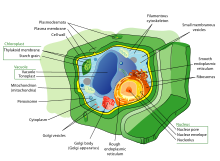Cells
Cells are the basis of all life on Earth, producing every living organism, from a single cellular bacteria, through to trillions of cells making up a human. All living species on Earth have cells.
Sub-Cellular Structures
[edit | edit source]Animal Cells
[edit | edit source]
Nucleus — contains the cells' genetic material. Visible as an opaque area through a light microscope. The nucleus controls all activities in the cell.
Cell membrane — the membrane encasing the cell. Flexible, allowing movement. Ensures the cell stays together
Mitochondria — release energy, through respiration, typically from glucose. Allows the cell to carry out metabolic functions
Ribosomes — carry out protein synthesis and the site of DNA transcription
Plant Cell
[edit | edit source]
Nucleus — contains the cell's genetic material. Visible as an opaque area through a light microscope.
Cell membrane — the membrane encasing the cell. Flexible, allowing movement. Ensures the cell's organelles do not spill out.
Cell wall — a strong layer of cellulose and other polysaccharides, making the cell rigid. Ensures that plants can stand upright
Chloroplasts — allow sunlight, water, and carbon dioxide to be converted to glucose and oxygen. Provide energy for the cell through photosynthesis.
Mitochondria — release energy, through respiration, typically from glucose (made by photosynthesis). Allows the cell to carry out metabolic functions
Vacuole — a fluid-filled sac within the cell containing cell sap, mineral ions, and other chemicals essential for the cell to function
Ribosomes — carry out protein synthesis and the site of DNA transcription
Prokaryotic (bacterial) Cell
[edit | edit source]Prokaryotic cells do not have a nucleus, unlike eukaryotic cells which have a nucleus.

Chromosomal DNA — DNA arranged in chromosomes. Contains most of a prokaryotic cells’ genetic material
Plasmid DNA — small rings of DNA within the cytoplasm of the cell. Allows bacteria to share genetic material throughout a population
Cell membrane — the membrane encasing the cell. Flexible, allowing movement. Ensures the cells organelles do not spill out.
Ribosomes — carry out protein synthesis and are the site of DNA transcription
Flagella — whip-like structures on bacteria, allowing them to move
Some Cells are Specialised to their Function
[edit | edit source]Sperm Cells
[edit | edit source]Sperm cells are the male gamete, used during sexual reproduction.

Acrosome — the region in the head of the sperm cell containing digestive enzymes. Used to ‘burrow’ through the cell membrane of the egg during fertilisation
Haploid nucleus — the nucleus of a sperm cell contains 23 chromosomes, as it is made by the process of meiosis. This creates haploid cells, which have ½ the number of chromosomes of the parent cell.
Mitochondria — sperm cells contain many mitochondrion, to release energy to move the flagellum. These are located in the mid piece
Tail — sperm cells have a tail (flagellum), a whip-like structure, allowing the cell to propel itself during fertilisation
Egg Cells
[edit | edit source]Egg cells are the female gamete, used during sexual reproduction.

Nutrients in the Cytoplasm — egg cells contain many nutrients in the cytoplasm to provide sufficient nutrition should the egg be fertilised. Allows the cell division and specialisation immediately after fertilisation to begin
Haploid nucleus — the nucleus of an egg cell contains 23 chromosomes (along with the sperm cell), as it is made through the process of meiosis
Changes in the Cell Membrane after Fertilisation — when an egg cell is fertilised with a sperm cell, the cell membrane changes, releasing chemicals that prevent any further sperm from fertilising the cell
Ciliated Epithelial Cell
[edit | edit source]
Ciliated epithelial cells have many, small, hair-like projections coming out of their cell membrane.
These projections are used to ‘waft’ waste products out of the trachea (wind pipe) and bronchioles. Mucus is transported out of the lungs with cilia, allowing it to enter the stomach, where it is digested.
These cells have a large proportion of mitochondria, as they use active methods (energy using) to ‘waft’ their hair-like projections.
Corona radiarta
[edit | edit source]The corona radiarta is a layer of cells covering an unfertilised egg or egg cell. During fertilisation, sperm must push through the layer to reach the outer layer of the egg, the zona pellucida.[1]
Cell death
[edit | edit source]Cell decomposition
[edit | edit source]When somebody has died, the cells in the human body stop receiving oxygen, and continue to function only for a few minutes. Carbon dioxide begins to build up, rupturing sacs inside the cells. The sacs contain enzymes that begin to digest the cells from the inside out. Cell death also occurs because of Necrosis, along with the work of bacteria in the body. A third example of cell death: The cell membranes break, releasing the inside fluids into the surrounding tissue.[2]
Original explanation of cell death
[edit | edit source]A person’s cells die every day, but the body is protecting itself. In a process called apoptosis, cells commit controlled suicide, if infected by viruses or harmful cancerous mutations.
